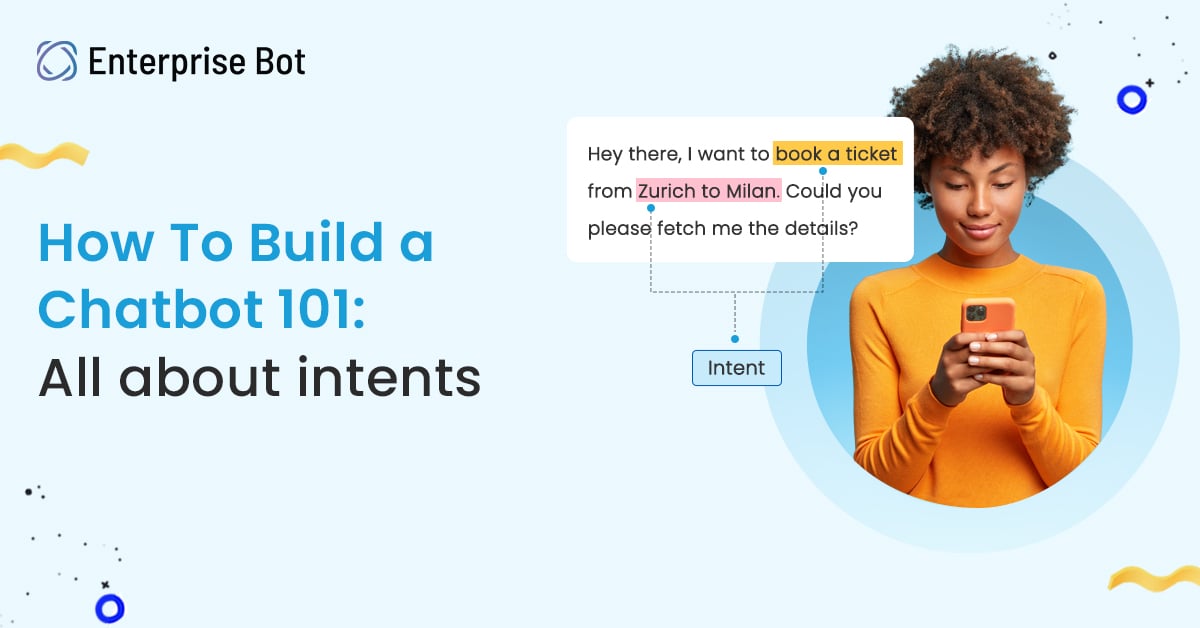Conversational AI Chatbots: Is It Really Critical for Your Customer Service?

At a Glance:
- 80% of respondents reported of already using chatbots or are planning to deploy by 2020. (Source: Oracle)
- Nearly 50% of customers said they would prefer buying from brands having chat options. (Source: Facebook)
- Implementing an effective chatbot solution will help to cut down efforts of live agents by 60–80% providing them to focus on tasks that really matter.
Customer: Hi! I want to book a ticket to York.
Service bot: Hello! Sure. Please give me a minute.
Meanwhile, at the back of the bot’s head:
What does the person want?
What language are they using?
What type is the request?
Which name, place, or thing is mentioned in the request?
Any other details?
Is the person happy or upset?
Well, not exactly its head but yes, that’s how a Conversational AI bot talks and thinks and takes action.
And they are everywhere today.
As more and more people prefer chatting with brands to buy products and services and get their issues resolved, businesses across industries are transforming their online presence by replacing traditional UIs with AI-first design.
Conversational AI chatbots are making customer experiences simpler and superior, with intuitive interfaces, speedier responses, and natural, human-like interactions.
Conversational AI chatbots capable of complex decision-making and employing technologies more advanced than linear, pre-programmed scripts or rigid yes/no trees are changing the way enterprises interact with their customers.
What are these intelligent assistants like? What exactly is Conversational AI?
Conversational AI is a set of technologies that enables computers to talk to humans in a natural, free-flowing manner.
What it really means is, using Conversational AI, computers can understand, process, and respond to human voice or text inputs just like any human would do.
And this advanced technology, when deployed in conjunction with bots or intelligent virtual agents (IVAs), can help people smoothly interact with complex systems in a faster way, and enable businesses to orchestrate efficient workflows, and deliver personalized experiences and effective customer support at scale.
“By 2020, customers will manage 85% of their relationship with the enterprise without interacting with a human.”
Source: Gartner
Though the adoption of artificial intelligence has grown in 3x over the past five years, it’s only one-third of the organizations who have implemented it in some form.
How exactly are Conversational AI chatbots more helpful?
1. Personalized experiences

Conversational AI chatbots are capable of engaging in highly personalized communications tailored to the needs of individuals they interact with.
They provide each individual with information relevant to their unique needs and suggest useful recommendations based on their historical data and distinctive journey. And multilingual Conversational AI chatbots can connect with people in their native languages to offer more empathetic support.
2. 24/7 support
Conversational AI chatbots are available 24/7 to serve people with reliable and prompt answers, eliminating long customer wait times. This round-the-clock availability, coupled with their timely, accurate, and robust support, can make people feel heard when they need it the most and strengthen their trust in the brand.
3. Improves Customer Service Interactions

Conversational AI chatbots can scale customer service and sales interactions indefinitely. For businesses, supplementing customer service teams with Conversational AI means reduced need for L1 support for managing repetitive FAQs, thousands of hours saved in answering routine queries, enhanced productivity, and empowerment of agents to carry out more challenging tasks. Besides, the chatbots require minimal upfront investment and are easy to integrate for quick deployment.
4. Omnichannel Experiences
Conversational AI chatbots can unify the fragmented digital and analogue worlds across messaging, chat, and voice in real-time and create an integrated, dynamic customer and agent experience.
By unifying multi-channel and cross-channel customer journeys into a singular view of insights for the agent and consistent, seamless support across platforms for the customer, conversational AI offers an end-to-end solution.
Interacting with AI, customers can engage on the platform of their choice across web, mobile, social media, and still be able to enjoy personalized experiences throughout the lifecycle of their multiple journeys.
5. Data-Driven Insights

Conversational AI chatbots are quick to integrate with CRM and extract data concerning the customer lifecycle stage, purchase history, past requests, and more, for support reps to refer in real-time. They can empower agents with new insights about customer behavior, language, and engagement history to craft more personalized experiences.
Checklists Why Should You Implement Chatbot
- They provide support 24/7, never on holidays.
- They are continuously learning and improving.
- They are flexible, behave per customers’ requirement.
- They never forget or miss out on critical information.
- They eliminate redundancy both for live agents and customers.
- They don’t need constant updates, hence low maintenance
So How Do Conversational AI Chatbots Work?
When a user sends in a chat or voice query, Conversational AI chatbots respond by processing and contextualizing the written or spoken input using Natural Language Processing, Machine Learning, Speech Recognition, and other language technologies.
What is Natural Language Processing?
Natural Language Processing is a computer program’s ability to convert unstructured human text or speech into structured data, match it with the right response in the knowledge database, and select a fitting reply.
It is AI’s ability to break user sentences down to their root level by understanding the many nuances of human language and recognizing that there is information to be parsed.
Conversational AI does that by extracting intents and entities, recognizing statistically significant patterns that it has been trained to identify, and considering factors such as synonyms, canonical word forms, grammar, slang, and more.
What’s more, Conversational AI analyzes customer text using NLP and responds appropriately in their language itself. This makes the interaction between the user and the AI seem natural and free-flowing, like between two people.
The process of converting human text into structured data for a machine to understand is Natural Language Understanding (NLU). The process of converting structured data back into the human text for a user to understand is Natural Language Generation (NLG).
NLP employs both these processes regularly to enable Conversational AI to interact with a human successfully.
When a user asks the Conversational AI chatbot a question, in response, the chatbot first recognizes the intents and entities.
Intent refers to what the user is trying to accomplish. It can be a single verb and noun combination, or a complex series of patterns that cover many possibilities in a single phrase. AI’s goal then is to match a user’s intent to a predefined task or question.
Entities refer to the elements that define and shape what is needed to complete the task or find the right answer, such as dates, times, locations, numbers, etc. Entity recognition refers to the AI’s ability to extract all the relevant information needed to accurately fulfill the user’s intent.
What is Machine Learning?
Machine learning is a form of the training model that allows computers to recognize the combinations of words that typically indicate intent and learn and improve from experience without being explicitly programmed by a human.
Within the world of machine learning, there are two main types of learning methods.
Supervised ML refers to analyzing a training dataset and using some form of learning algorithm to make predictions, compare its output with the correct, intended outputs, and identify errors.
This is then used to modify the model accordingly — making it more accurate over time.
Unsupervised ML, on the other hand, refers to analyzing a set of data that isn’t explicitly classified or labeled, and it is typically used after the bot has been deployed for internal testing or to the field.
For Conversational AI chatbots, unsupervised ML usually involves automatically expanding a bot’s language model by adding all successfully identified utterances to its model.
Task Execution
Conversational AI can empower customers to get things done faster and more efficiently. Bots and IVAs can collect, modify, and post information to systems of record, request reports from backend systems, retrieve pertinent information, alert humans, and more.
Thanks to the prevalence of cloud computing and API libraries’ availability, they can now also unify disparate systems by enabling interplay between underlying technologies.
Conversational Intelligence
Human language consists of many complex rules and nuances, including multiple word meanings, interruptions, slang, clarifications, and more — all of which can fundamentally change the meaning and importance of a user utterance.
To account for this, conversational AI provides several capabilities that allow you to go beyond predefined and linear resolution paths:
Dialog Turn Management
Conversations often consist of many twists and turns. Conversational AI enables developers to craft fluid, complex, and dynamic dialogs. Examples include pausing, starting, and resuming tasks, processing multiple intents in a single utterance, and amending entities in a conversation.
Context Management
Having contextual knowledge means that when a customer asks a follow-up question, Conversational AI already knows what the customer is talking about rather than needing to ask previously provided information all over again.
The best Conversational AI has a memory so that users do not have to repeat themselves and can speak and reason with the bot like you would with a real person.
Sentiment Analysis
Emotion and tone can significantly change a word’s meaning. Conversational AI allows bots to identify key triggers, including connotation and word placement, that signal an emotion’s type and intensity. This can assess user inputs, trigger custom flows, bring in human agents, and steer conversations.
Multilingual Support
Modern business is global. Conversational AI supports nearly every major language, allowing you to expand into new markets more and serve more customers.
It means you can work with your choice of language when defining intents, entities, training data, and more.


